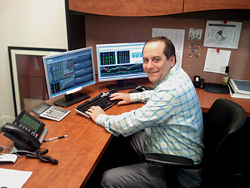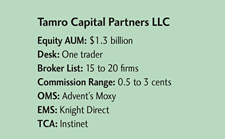Block trading isn’t what it used to be, particularly for small-cap stocks. According to Tamro Capital Partner’s Mark Herman, a 20-year trading veteran, what qualified as a small block trade just five years ago would now be considered a sizable print. And most blocks he trades are never the size he wants.

"For the stocks I am trading, it’s nearly impossible to find them in blocks," Herman said. "They do exist, but they are few and far between, in terms of finding natural size."
Ideally, he’d like to trade blocks of between 25,000 and 50,000 shares-or even larger. However, Herman knows the perils of trading small caps in size–and tipping off the marketplace.
That’s why he says fewer and bigger block trades are better than more blocks of lesser size. It minimizes his transaction costs, too, helping employee-owned Tamro keep trading costs down.
Tamro Capital, with $1.3 billion in equities under management, finds fragmentation its biggest nemesis in the small-cap arena, among companies capitalized from between $100 million and $2.5 billion.
Herman knows that size is out there, somewhere. But he shrugs off the difficulties of sourcing liquidity, pointing out that trading has never been easy-even going back to his days as a buyside trader at O’Connor/Swiss Bank, where he traded derivatives after graduating from college.
His father, Jim, a business professor at the University of South Florida, would discuss finance at breakfast. An enamored Herman heard enough to know he wanted a career on Wall Street.

After his stint at O’Connor/Swiss, Herman completed a master’s in finance at Colorado State University and then helped build a trading desk at a Denver-based research boutique. He joined Knight Capital’s Dallas office in 2006. He ran its trading desk in the direct-market-access group, learning about electronic trading, including FIX protocols, algorithms and the various alternative trading systems, such as dark pools.
Herman is completing his third year with Tamro, a 14-person firm based in Alexandria, Va. But his trading strategy has not wavered since he began there.
"We’re always out looking for blocks, but market fragmentation comes into play," Herman said. "It is hard to find liquidity at any given price throughout the day."
To find natural liquidity, he relies on his brokers. But he also uses direct market access and algorithms, accounting for 30 to 40 percent of his executed flow. Herman says it does not matter how he finds liquidity, as long as he finds it in sufficient size-and quietly.
And asking his brokers to commit capital is a nonstarter. Tamro doesn’t want to create a commitment to any single broker.
"We don’t want to create any undue competition in the illiquid names we are in," Herman said. "It’s hard for brokers to commit capital just because of the liquidity concerns in the securities we deal in."



